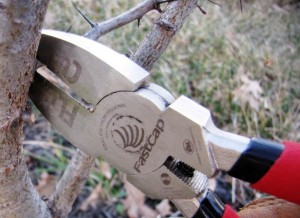Ready, set . . . It’s “go” time in the garden, even if you can’t start planting yet
This is about to become the busiest time of year around here – here being the Upper Midwest/Great Lakes area of the country. No matter how early or late spring actually decides to put itself in gear, there’s plenty to be done, even before the weather becomes reliably warm and some actual gardening happens.
Sometimes just making a list of all the possible things that need doing, and then working your way down through that list, ticking off tasks one-by-one, will keep you motivated. Having a list also helps you delegate responsibilities if you’re fortunate enough to have garden help.
General Clean-up.
Winter has a way of blowing things around in the yard and sometimes it ends up in your garden, wrapped around shrubs and stuffed under last year’s grasses and perennials that you let stay for winter interest or wildlife. If you have a lot of trees, you might have thick layers of leaf cover, which can foster mold and smother emerging plants. Take one bed at a time and clean it out, composting what you can and disposing of whatever else.
Tools.
Some gardeners clean and sharpen their tools at the end of the season before storing them for the winter, but if you didn’t get around to it then, now is a good time. It always feels better to work with clean, sharp tools and it often makes your work more efficient too!
Pruning.
Grab your pruners and cut the dead from the perennial plants, which are showing new growth by now. Cut your grasses back, even the ones like Liriope, which may still be somewhat green from last year’s growth. They’ll look better without their bleached out ends and it won’t hurt them a bit.
Weeding.
Spring rains soften the ground and make early-growing weeds easier to pull out, even dandelions. You may left some annuals in the garden last fall, so those can be pulled too. Be careful, of course, to stay on garden paths and not to walk in your garden beds any more than necessary, so that you don’t compact the soil.
Painting.
Inspect the accoutrements in your yard and garden to see if they could use some touching up. Winter can be hard on painted or stained wood items, such as trellises and arbors. These things are also easier to paint if they’re free of growth from vines. Patio furniture might need a little help, too.
Edging.
The edges of flower beds will be much easier to fine tune while the ground is soft, so go ahead and clean those up, either with an edging spade or power edger. Just doing this one task, though time-consuming, will brighten up your garden beds no matter what the beds themselves look like.
Seeds.
The garden centers are fully stocked with seeds, so make your final decisions on what you’ll plant and buy them. There are several cool season crops, like peas, that can be planted as soon as the soil can be worked. Don’t be tempted to work it too soon though. Wet soil should be allowed to dry to a crumbly stage before attempting to sow seeds.
As you’re working in and around your garden beds, you’ll naturally try to assess what made it through the winter and what didn’t, but it’s still too early to be concerned. Some plants are notoriously slow at making an appearance. Just when I’ve about given up on something is when I look a little closer and see signs of life.
Commonly late to the spring party are such things as butterfly weed (Asclepias tuberosa), Rose of Sharon (Hibiscus syriacus), hardy hibiscus (Hibiscus moscheutos), butterfly bush (Buddleia), leadwort or plumbago (Ceratostigma), beautyberry (Callicarpa americana), Russian sage (Perovskia atriplicifolia), Joe Pye weed (Eupatorium) and balloon flower (Platycodon grandiflorus).
The things on this list should keep you busy until the weather allows you to do more. Don’t panic if you can’t get things planted at the earliest possible time. Late-planted seeds seem to catch up once temperatures stabilize and are reliably warm.

